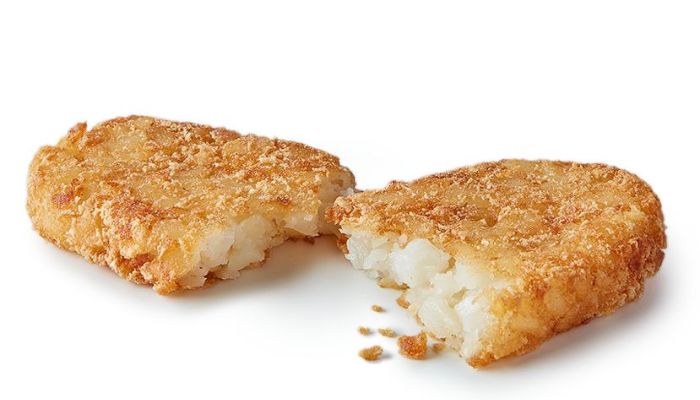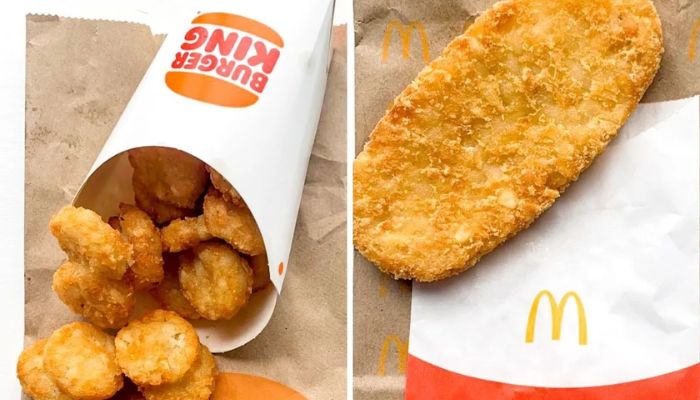Since I’ve been a nutritionist and dietitian for seven years, people often ask me how many calories are in breakfast foods like McDonald’s hashbrowns.
As a busy mom of two young children, I can see why people might want to grab a quick breakfast on the go from the McDonald’s drive-thru. It is important to know what you are eating, though, so you can make smart decisions.
Many people don’t realize how many calories, fats, and other nutrients are in fast food breakfast foods like hashbrowns, which I’ve seen over many years of work. My goal is to give you the information you need so you can eat your favorite foods in moderation as part of a healthy diet.
McDonald’s Hashbrown Calories
Let’s look at the nutrition facts for McDonald’s hash browns:
Calories in a McDonald’s Hashbrown
There are 150 calories in a medium-sized McDonald’s hashbrown.
That’s a lot of calories for just one side dish. Here are some other 150-calorie breakfast options to give you an idea:
- One piece of whole wheat toast with one tablespoon of peanut butter
- 3/4 cup of Greek yogurt with only half a cup of blueberries
- One orange and one hard-boiled egg
You can see that 150 calories isn’t too many, but there are healthier options that will give you more nutrition for your money.
Fat and Cholesterol
There are 8 grams of fat in every McDonald’s hashbrown, 3 grams of which are saturated fat. It does not have cholesterol.
The American Heart Association says that saturated fat shouldn’t make up more than 5 to 6 percent of your daily calories. If you eat 2,000 calories a day, this is equal to 13 grams of saturated fat.
One hash brown from McDonald’s gives you almost 25% of the saturated fat you should eat every day. The high amount of saturated fat is a cause for concern, since diets high in saturated fat are linked to higher levels of LDL (“bad”) cholesterol and a higher risk of heart disease.
Carbohydrates
A hash brown from McDonald’s has 19 grams of carbs, which is 6% of the Daily Value (DV) for a 2,000-calorie diet.
Fiber and sugar make up less than 1 gram of these carbs. Hashbrowns are mostly made from potatoes, which are a starchy vegetable that mostly contains complex carbs that come from starch.
It doesn’t have too many carbs (19 grams), but it does have a lot of fat, which means it has a lot of calories from fat and carbs without much nutritional value.
Protein
A hash brown from McDonald’s has 2 grams of protein, which is 4% of the daily value. Considering the number of calories, fat, and carbs, this is a pretty small amount.
Greek yogurt, eggs, and peanut butter are all healthy breakfast foods that have more protein per calorie. Protein makes you feel fuller for longer after you eat.
Micronutrients
Hashbrowns from McDonald’s have some potassium and iron; they give you 2% and 4% of your daily value, respectively.
But they don’t have enough of other vitamins and minerals that are found in whole foods like nuts, seeds, fresh fruits and vegetables, and whole grains. As a dietitian, I always tell people that supplements aren’t always the best way to get nutrients.
Sodium
There are 290 mg of sodium in each hashbrown, which is 12% of the daily value. Sodium is an important nutrient, but 2,300 mg per day is the daily limit that is suggested.
Watch how much sodium you eat from fast food, because it can add up quickly if you eat them a lot. High blood pressure, heart disease, and stroke are all linked to eating too much salt.
How to Cook
Hash browns at McDonald’s are deep-fried in vegetable oil. Food that is deep-fried takes in a lot of oil while it is cooking, which adds a lot of calories from fat.
To avoid eating too many calories, it’s better to bake, grill, roast, or pan-fry with little to no oil.
How Much McDonald’s Hash Browns Is Enough?
The nutrition facts show that McDonald’s hashbrowns have a lot of calories, fat, carbs, and sodium compared to how many vitamins and minerals they have. But if you’re careful, a hashbrown once in a while can be part of a healthy diet.
If you want to eat hash browns and other fast food in moderation, here are some tips:
- Don’t go bigger than a small or medium. Not “supersizing” your order is important.
- To help you feel full, eat it with a protein-rich food like Greek yogurt or eggs.
- Instead of fries, get a side salad for extra health.
- For the rest of the day, watch how much you eat. Do not eat too much to “make up” for the calories in the hash browns.
- To cut down on fat and salt, don’t use sauces and dressings that are high in calories.
- Have it as a treat once in a while, but not every day.
- As your main foods, eat a lot of whole foods like fruits, vegetables, lean proteins, whole grains, nuts, and seeds to keep your balance.
Conclusion
Each serving of McDonald’s hash browns has 150 calories, 8 grams of fat, 19 grams of carbs, and 2 grams of protein. You can eat them once in a while as part of a healthy eating plan, but it’s best to limit them because they are high in sodium, fat, and calories and don’t provide much nutrition.
When my clients go to a fast food restaurant for breakfast, I tell them to read the nutrition labels and look for foods that have more protein, fiber, and micronutrients. But most importantly, try to make a habit of eating whole foods that have been minimally processed. You can still enjoy your favorite foods and meet your health and nutrition goals if you only eat fast food once in a while instead of every day.

Pooja Bohra is a certified nutritionist with over 8 years of experience in the field. At UnderCalories.com, she specializes in creating personalized dietary plans and promoting sustainable health practices, grounded in evidence-based research. Pooja is dedicated to helping individuals achieve their wellness goals. Follow her on Instagram for the latest tips and insights on balanced nutrition and healthy living.

